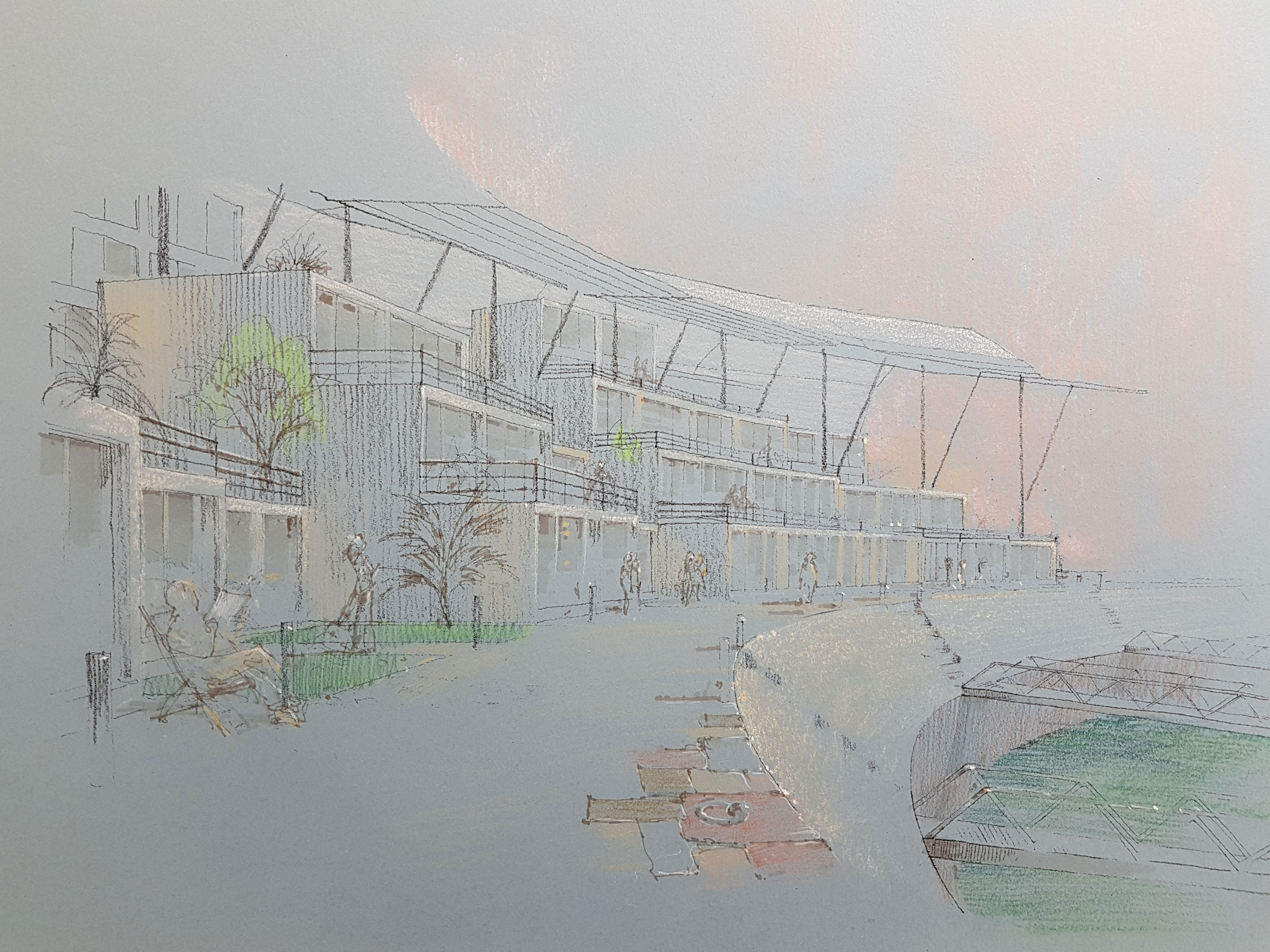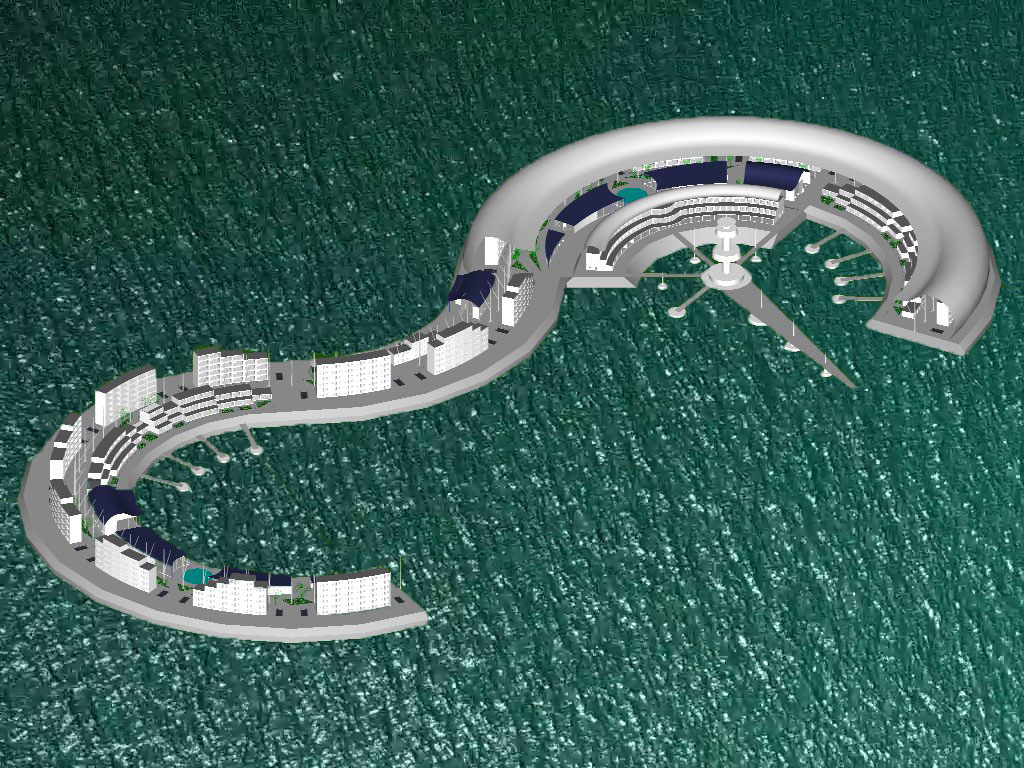Sea City
Sea City celebrates its 25th Anniversary.
Contents |
A concept project for a sustainable oceanic settlement
Background
Cast your minds back to the mid 90's. Global warming was in the news (even then), and the Kyoto Protocol had just been signed. I was a student at Hull School of Architecture (now sadly closed). The school had been involved in the Coastwise Europe project, where schools of architecture from around Europe had studied a stretch of coastline near to their University. We looked at the stretch of coast from Spurn Point at the tip of the Humber estuary to Flamborough head in the north. It was interesting to discover the number of small settlements and villages, which had been lost due to coastal erosion over the years. For small settlements such as these, government policy was not to try and defend them (as this can exacerbate the problem further down the coast) - instead people were forced to abandon their properties and simply retreat further in land. With the anticipated impact of global warming causing sea levels to rise, this situation was clearly only going to get worse. As a result, I started to look at an alternative solution – what if instead of retreating, we could create an oceanic settlement located off the coast, which wouldn't be affected by the rising sea levels? To this end, I started researching the credibility of building oceanic settlements off the coast of Britain, in a dissertation entitled 'All at Sea'.
Community
Apart from the potential to accommodate displaced communities, an oceanic settlement could also be a destination in itself. A hotel and leisure facilities could attract people looking to escape from a hectic life on the mainland – with activities such as water sports, diving and fishing, or simply unwinding with the relaxing sound of the sea. The settlement could also be the base for a satellite campus for the University of Hull, for courses involved with the study of the sea and marine life. The North Sea is already home to small communities in the form of off-shore oil and gas rigs. However, the accommodation is poor quality and means that the workers have to work shifts. What if there was a near-by settlement, with all the facilities of a small village on the mainland, where they could stay with their families? The fishing industry could also benefit from having an off-shore base, with processing facilities and workshops, which would reduce travel and costs. Before long there is the basis for a mixed community, with all the supporting facilities of shops, cinema, gymnasium etc. A regular ferry service to the mainland, would ensure a healthy exchange of people, produce and culture.
i) Industrial Zone
ii) Leisure Centre
iii) Residential Quarter
Construction
Together with an engineer from the Easington Gas Terminal on the Holderness coast, I investigated the best location for an off-shore settlement, based on weather conditions and the depth of the sea bed etc. Initially, I started looking at a 'fixed' settlement, with piled construction. This technique has a rich heritage, from Asian ‘water villages’ to the British pleasure pier, and is still practised today. However, inspired by floating oil rigs and pontoon bridges, the opportunities of a floating, more dynamic settlement, soon became apparent. The versatility of floating foundations would enable the structure to be towed out to sea before being joined together and secured onto the seabed. This would facilitate land based, dry dock construction, and enable an off-shore development to be constructed in a piecemeal fashion. The settlement could then evolve in response to demand, with different configurations to suit the location. Having created a secure floating substructure, the superstructure could then be developed. Accommodation units would be prefabricated and assembled on site (old shipping containers could be reppropriated for this purpose), whilst the larger 'public' buildings would be built utilising the principles of 'high-tech' architecture, so that they could be readily assembled (and dismantled). With a leeward entrance, the substructure would create a protected harbour, whilst a tensile translucent fabric canopy would provide protection from the worst of the weather and evoke nautical images of sails.
Sea City – Option 1 ( Original)
Sea City – Option 2
Sea City – Option 3
Sustainability
An oceanic settlement, constructed from pre-fabricated units on floating pontoons, would have minimal effect on the environment. It could also utilise the energy from the sea, sun and wind. Since my original scheme, off-shore wind farms have become commonplace, and are now a big industry in Hull. As the old oil and gas fields are wound down, there is now a more sustainable industry in the North Sea - which will require maintaining. With a diverse population, a mixed use floating settlement would also be socially and economically sustainable. Recent events further afield have also shown how a floating off-shore settlement could provide sanctuary to displaced populations throughout the world.
The Future
Originally designed in 1997, the graphics look a bit dated now, but the concept is just as relevant today. The slow response of governments to climate change, means that global warming and rising sea levels are an even more pressing issue now. There has also been renewed interest in building at sea. The Seasteading Institute, based in California, promotes the concept of floating oceanic communities and recently work has begun on a floating settlement in the Maldives – a country on the front line of rising sea levels. Since Sea City was first designed, advances in technology and communications mean that people and businesses can now work remotely from the the mainland, without the extra costs of land based property. First conceived in the maritime city of Hull, Sea City could be the catalyst for our seafaring nation to once again take to the worlds oceans in search of a more sustainable future....
“The sound, the light, the wetness of living on water changes earthbound society, offering a new perspective of openness, a new sensitivity to human relationships, which are not defined by earth’s boundaries.” Bertrand Goldberg
Concept, design and images provided by Tim Chetham of Chetham Architecture Design (user CAD)
--CAD
Related articles on Designing Buildings
Featured articles and news
Amendment to the GB Energy Bill welcomed by ECA
Move prevents nationally-owned energy company from investing in solar panels produced by modern slavery.
Gregor Harvie argues that AI is state-sanctioned theft of IP.
Heat pumps, vehicle chargers and heating appliances must be sold with smart functionality.
Experimental AI housing target help for councils
Experimental AI could help councils meet housing targets by digitising records.
New-style degrees set for reformed ARB accreditation
Following the ARB Tomorrow's Architects competency outcomes for Architects.
BSRIA Occupant Wellbeing survey BOW
Occupant satisfaction and wellbeing tool inc. physical environment, indoor facilities, functionality and accessibility.
Preserving, waterproofing and decorating buildings.
Many resources for visitors aswell as new features for members.
Using technology to empower communities
The Community data platform; capturing the DNA of a place and fostering participation, for better design.
Heat pump and wind turbine sound calculations for PDRs
MCS publish updated sound calculation standards for permitted development installations.
Homes England creates largest housing-led site in the North
Successful, 34 hectare land acquisition with the residential allocation now completed.
Scottish apprenticeship training proposals
General support although better accountability and transparency is sought.
The history of building regulations
A story of belated action in response to crisis.
Moisture, fire safety and emerging trends in living walls
How wet is your wall?
Current policy explained and newly published consultation by the UK and Welsh Governments.
British architecture 1919–39. Book review.
Conservation of listed prefabs in Moseley.
Energy industry calls for urgent reform.































